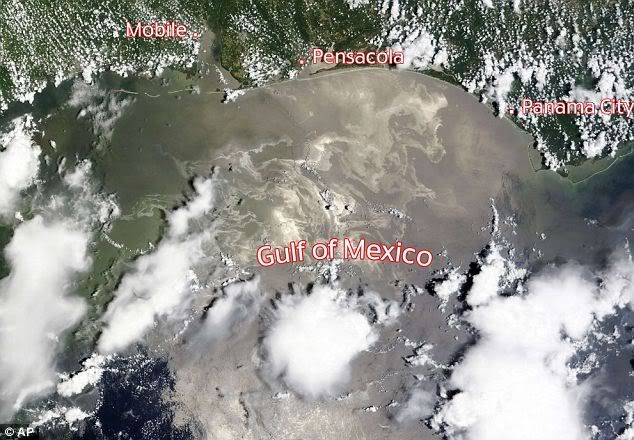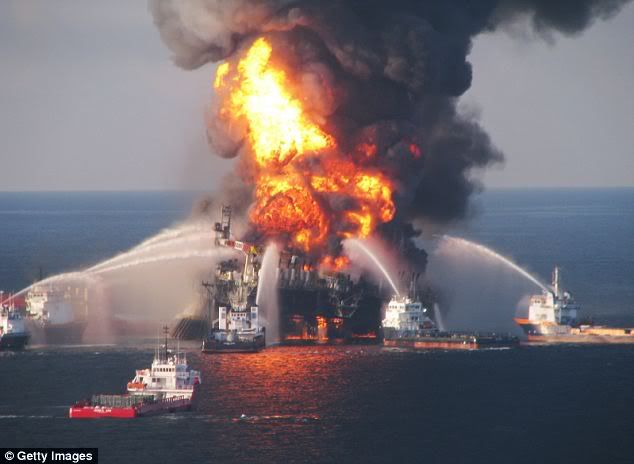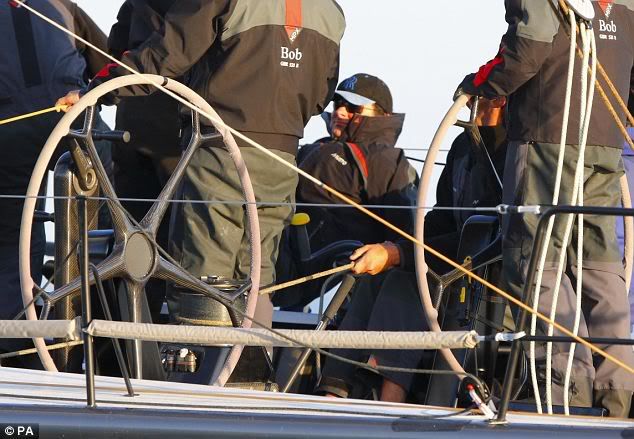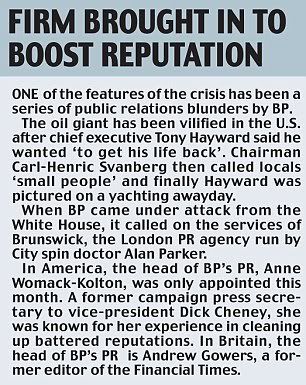
The extent of the oil spill from the Deepwater Horizon disaster is clearly visible in this satellite picture taken last Friday and released today by Nasa. The oil appears as varying shades of white, as sunlight is reflected off its surface

Fire boats battle a fire at the off shore oil rig Deepwater Horizon on April 21 in the Gulf of Mexico. Eleven workers died in the explosion

Day off: Mr Hayward on his yacht 'Bob' during the race around the Isle of Wight on Sarutday
Evidence was mounting last night that BP cut corners on safety on the rig at the centre of the catastrophic Gulf oil spill.
A worker on the Deepwater Horizon rig claims he flagged up a problem on the most critical piece of equipment weeks before the disaster. But managers did not fix it, said Tyrone Benton.
Instead they simply shut down the part that was not working and switched to an alternative part, a decision described as 'unacceptable' by experts. Soon after, on April 20, the rig exploded, killing 11 men and sending millions of gallons of oil into the Gulf of Mexico.
The critical safety device, known as the blowout preventer, failed. BP has repeatedly claimed that it did not put profits ahead of safety – the Deepwater rig cost the firm £337,000 a day to run.
But Mr Benton said in an interview with BBC's Panorama that he found a problem with the 'blind shear ram', a set of shears on the blowout preventer which close the well in the event of a disaster.
He noticed there was a leak on one of the two pods which contain the hydraulics and electronics that control the shears. 'We saw a leak on the pod, so by seeing the leak we informed the company men,' he said.

Tyrone Benton tells the BBC's Panorama programme how he warned BP chiefs of possible faults with the blowout preventer on the Deepwater Horizon rig

Hobby: BP Chief Executive Tony Hayward's yacht Bob, during the JP Morgan Asset Management Round the Island Race


'They have a control room where they could turn off that pod and turn on the other one, so that they don't have to stop production. They shut it down and worked off another pod.'
Mr Benton said his supervisor e-mailed both BP and drilling company Transocean about the leaks when they were discovered.
He did not know whether the leaking pod was turned back on before the disaster or not.
The only way to resolve the issue was to stop the well completely but that did not happen because it would 'cost a lot of money', he added.
Professor Tad Patzek, petroleum expert at the University of Texas, said carrying on with production was a mistake.
'To shut it down and work off another pod is unacceptable. If you see any evidence of the blowout preventer not functioning properly, you should fix it by whatever means possible,' he said.
In a separate allegation, it was claimed that only one blind shear ram was installed on the blowout preventer at the rig, when there should have been two as an extra safety measure.
Congress has identified numerous other problems with the blowout preventer, including a design issue, unexpected modifications and a flat battery.
Giving evidence before Congress last week, BP chief executive Tony Hayward said the oil industry had to recognise that the 54-ft tall piece of machinery needed a 'fundamental redesign'.
He also told senators: 'There is nothing I have seen in the evidence so far that suggests that anyone put cost ahead of safety.'







0 comments:
Post a Comment